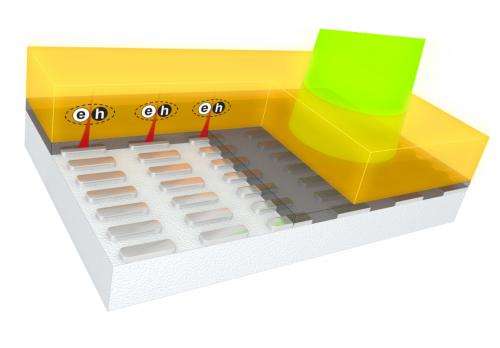New particle might make quantum condensation at room temperature possible

Researchers from FOM Institute AMOLF, Philips Research, and the Autonomous University of Madrid have identified a new type of particle that might make quantum condensation possible at room temperature. The particles, so called PEPs, could be used for fundamental studies on quantum mechanics and applications in lasers and LEDs. The researchers published their results on 18 October in Physical Review Letters.
In quantum condensation (also known as Bose-Einstein condensation) microscopic particles with different energy levels collapse into a single macroscopic quantum state. In that state, particles can no longer be distinguished. They lose their individuality and so the matter can be considered to be one 'superparticle'.
Quantum condensation was predicted in the 1920s by Bose and Einstein, who theorised that particles will form a condensate at very low temperatures. The first experimental demonstration of the quantum condensate followed in the 1990s, when a gas of atoms was cooled to just a few billionths of a degree above absolute zero (-273°C). The need for such an extremely low temperature is related to the mass of the particles: the heavier the particles, the lower the temperature at which condensation occurs. This motivated an ongoing search for light particles that may condense at higher temperatures than atoms. The eventual goal is to find particles that form a condensate at room temperature.
PEPs
The researchers have created a particle that is a potential candidate for fulfilling the quest: the extremely light plasmon-exciton-polariton (PEP). This particle is hybrid between light and matter particles. It consists of photons (light particles), plasmons (particles composed of electrons oscillating in metallic nanoparticles) and excitons (charged particles in organic molecules).
The researchers made PEPs using an array of metallic nanoparticles coated with molecules that emit light. This system generates PEPs when it is loaded with energy. Through a careful design of the coupling between plasmons, excitons and photons, the researchers created PEPs with a mass a trillion times smaller than the mass of atoms.
Because of their small mass, these PEPs are suitable candidates for quantum condensation even at room temperature. However, due to losses in the system (such as absorption in the metal) PEPs have a short lifespan, which makes keeping them around long enough to condense a challenge.
First steps
The researchers have shown the first steps towards condensation of PEPs, demonstrating that PEPs cool down as their density increases. However, in the current system cooling down is limited by properties of the organic molecules used in the experiments, which lead to a saturation of the PEP density before condensation sets in. The researchers envisage that it should be possible to overcome these challenges in the future.
Applications
To a large extent, PEPs are composed of photons. Therefore, their decay results in the emission of light. This emitted light has unique properties, which could constitute the basis of new optical devices. In view of recent advances from AMOLF and Philips Research towards improving white LEDs with similar systems, the researchers suggest that light from a Bose-Einstein condensate might illuminate our living rooms in the future.
Journal information: Physical Review Letters




















